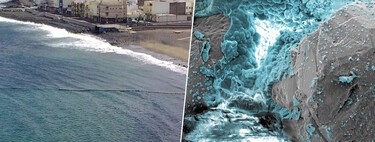Hurricanes are getting out of control. An example is that, although we had been anticipating that they would arrive in Spain for some time, they did not finish doing so… until the last blows of Kirk and Leslie’s tail appeared. They have left rain and winds in the north of the Peninsula, but in the North American southeast it is much more common, with shocking hurricanes like Helene or the virulent Milton as the closest examples.
In an effort to protect itself, DARPA has been funding coastal shield research for years. And they believe that walls of mollusks and corals will be the solution.
Protecting the bases. As they point At Wired, it all started in 2018. The Hurricane Michael hit the Gulf of Mexico, taking out several United States fighter planes with damage estimated at 6 billion at Tyndall Air Force Base. That they take houses is one thing, but that they overturn our fighters is another, the Pentagon must have thought, and with more than 1,700 coastal bases around the world, it was time to move on to defense.
Thus, and with 67.6 million dollars for research, the Defense Advanced Research Projects Agency -DARPA- undertook in 2022 a defense initiative to mitigate the effects of waves and wind when they approach coasts, specifically US bases.
Reefense. Currently, the Pentagon protects its coastal bases as it does civilian areas: with walls. It is something that we are seeing, for example, in New York, where they are building walls to stop the sea (not because of storms, but because the city… is sinking). The current method consists of erecting retaining walls with large concrete blocks or rocks that divert wave energy.
Precisely, that is the problem: diverting the energy from the water means that someone else will receive it and, furthermore, the energy is not absorbed, so they deteriorate little by little. It must also be taken into account that they are static and, whether due to the force of the water or the rise in sea level, they can easily become out of date. Thus, the defense project that DARPA has commissioned from three American universities is called Reefensea mix between reef —reef— and defense -defense-. And more than a boardwalk, it is an organic wall.


oyster wall. Specifically, a wall of oysters and other mollusks. Each university has guidelines to develop their containment prototypes, but they are all more or less the same and Rutgers University already has its prototype ready to go into action. It is a 50 meter wide structure made up of three structures weighing about 20 tons each and with holes between them. In total, there are 788 interlocking concrete modules, each one 60 centimeters wide and 30 centimeters high.
The idea is not to stop the water, but to absorb the push of the waves and the Rutgers team claims that this structure alone can absorb 70% of that force. Now, the idea is that this boardwalk 2.0 is colonized by mollusks. When that happens, researchers believe the wall will absorb 90% of the wave energy.
a lot of sense. The bivalves stack on top of each other with bonds so strong that they are inspiring the creation of “cement” for other uses in marine structures. They form mounds and, when they are hit by a wave, as there are so many cracks, nooks and different shapes, the water disperses, so the energy diffuses between the gaps.
Furthermore, unlike a concrete wall that only wears away, the structures in which there are oysters grow vertically as more and more join the whole. There are those who are already cultivating oysters to form these structures on the coasts and what they want to enhance in this marine shield is what already disperses the artificial structure added to the effect of the oysters.


and coral. Now, in temperate waters, oysters can be a solution, but in warmer climates like those of tropical bases, corals are the key. Coral reefs are very efficient at dispersing marine energy, since they extend out to sea and, due to the irregularity of their shapes, when the water reaches the coast, the energy has been almost completely dispersed.
The problem is that the Hawaiian islands are running out of coastline, and programs to create these artificial reefs would come into play, such as the one being developed in the Applied Research Laboratory of the University of Hawaii, also within the project. Reefense. This shield will be compound by two 50-meter-wide barriers arranged in a row, with another 20 pyramid-shaped obstacles and a hollow interior that will help disperse marine energy. These structures have a porous finish to encourage corals to colonize them.
Challenges. The University of Hawaii project will be like “a concrete sponge,” says the director of the Future Coral Reef Laboratory at the University of Miami, the third university doing research for DARPA. The problem is… illnesses and times. If a disease destroys the mollusks, the effect of the wall will decrease and that is why, at Rutgers, they are selecting the most resistant individuals so that they can reproduce. David Bushek, who directs the Haskin Shellfish Research Laboratory at Rutgers, says it’s something that usually takes three years, but his team has done it in one.
Something similar happens with corals. At the University of Miami they are developing natural corals that tolerate heat better: between 1.5 and 2 degrees Celsius. In this way, it is more likely that with the increase in sea temperatures, the corals will not weaken. However, there are those who consider that the times are being very tight. DARPA has to present its report in 2027, so work that has not been done will not continue to be funded and Donna Marie Bilkovic, professor at the Virginianna Marine Science Institute, tells Wired that systematic monitoring must be done to be able to understand what works best, but “there’s just no funding.”
Not just for the army. In any case, when the date arrives on which DARPA will present the report, the data collected by the different teams will surely be useful to develop solutions beyond the current retaining walls. At the moment, it is something focused on the military forces, but Catherine Campbell, director of Reefense at DARPA, comments that “it’s not something just tailored for the military. We have to be aligned with the costs for the civilian sector, and that gives it potential for commercialization.”
We’ll see what conclusions they come to in a few years, but with storms that seem to increase year after year and rising sea levels, finding solutions beyond simple concrete doesn’t seem like a bad idea.
Images | Coral Restoration (2), rutgers, Makai Ocean Engineering
In Xataka | Adding cane sugar to cement can be the key to achieving self-healing concrete














![[Img #74683]](https://thelatestnews.world/wp-content/uploads/2024/12/The-main-mistakes-to-avoid-when-betting-on-electronic-sports-300x200.jpg)

Add Comment